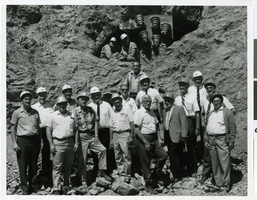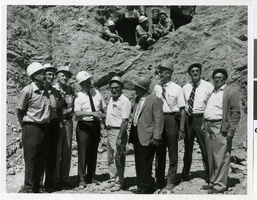Search the Special Collections and Archives Portal
Search Results

Photograph of Key federal, state and contractor representatives who were on hand when the mole broke through the tunnel, Las Vegas, Nevada, 6-26-69
Date
Archival Collection
Description
Image

Photograph of Key federal, state and contractor representatives who were on hand when the mole broke through the tunnel, Las Vegas, Nevada, 6-26-69
Date
Archival Collection
Description
Image
Spencer and Georgia Butterfield Papers
Identifier
Abstract
The Spencer and Georgia Butterfield Papers (1890s-1978) consist primarily of photographs and scrapbooks pertaining to Spencer and Georgia Butterfield, a prominent Las Vegas, Nevada couple involved in local business and civic activities. The collection also includes newspaper clippings of their social activities, correspondence, and assorted personal memorabilia.
Archival Collection
Albert S. Henderson Papers
Identifier
Abstract
The Albert S. Henderson Papers (1879-1962), document his career and service as a district judge in Las Vegas, Nevada. Included are correspondence, a personal statement from his election campaign, certificates and proclamations, his memorial book, numerous newspaper clippings, an 1879 edition of Eureka and Its Resources, and various ephemera: union cards, name tags, and election cards.
Archival Collection
Edward C. Light Schematic Drawings of the Hughes H-4 Hercules "Spruce Goose" Seaplane
Identifier
Abstract
The Edward C. Light Schematic Drawings of the Hughes H-4 Hercules "Spruce Goose" Seaplane consists of blueline print reproductions of sheets created between 1941 and 1950 containing schematic engineering design drawings pertaining to the aircraft's rudder and flight control system assembly and installation. Types of drawings include full body perspective diagrams, structural sections, elevations, and plans.
Archival Collection
Strutt Hurley Collection on the Southern Nevada Association of Pride, Inc. (SNAPI) and Las Vegas Gay Pride
Identifier
Abstract
The Strutt Hurley Collection on the Southern Nevada Pride Association, Inc. (SNAPI) and Las Vegas Pride (1989-2000) contains materials collected and produced by Strutt Hurley during her tenure as Director of Entertainment of SNAPI. Materials include meeting minutes, advertising contracts, Las Vegas Pride programs, and ephemera collected from Pride celebrations in Las Vegas, Nevada and other parts of the United States and the world.
Archival Collection
Blue Diamond Mine Corporate Records
Identifier
Abstract
The Blue Diamond Mine Corporate Records (1918-2005) consist of operational and organization records of the gypsum mining and milling operations located in southwest Clark County, Nevada. Materials include operational records related to individual boring sites at the mine; milling operations and statistics; and equipment operations and statistics, including maps, field notebooks, and photographs. There are also daily, weekly, and monthly organizational records related to employee work schedules and safety reports for the mining operations, including accident reports and a safety education training program.
Archival Collection
Jay Sarno Papers
Identifier
Abstract
This collection is comprised of publicity and promotional materials documenting the Caesar's Palace Hotel and Casino Resort and the Circus Circus Hotel and Casino Resort. Both resorts were a result of hotel and casino developer Jay Sarno. There is a small amount of material on Sarno in the collection such as newspaper clippings, a press release, and a copy of Sarno's FBI investigation file. The collection includes property records, magazine and newspaper clippings, informational brochures from the two properties, press kits, and a small amount of correspondence. It also includes a prospectus and stock offerings for Sarno's never-realized Grandissimo Hotel and Casino resort that would have been built on Interstate 15 to the west of the Las Vegas Strip.
Archival Collection
Doris Hancock Papers
Identifier
Abstract
The Doris Hancock Papers (1895-1987) consist of school memorabilia, correspondence, sketches, two scrapbooks, and material from her involvement in the Las Vegas Art League. Also included are materials about Southern Nevada and surrounding areas, particularly mining towns, Colorado River, Boulder Dam, Red Rock Canyon, early Las Vegas, and Death Valley.
Archival Collection
Minsky's Burlesque Records
Identifier
Abstract
Minsky's Burlesque Records (1922-1978) contain scripts, publicity, photographs, financial records, payroll records, sheet music, newspaper clippings, contracts, and correspondence. Also included are the personal papers of noted burlesque producer Harold Minsky, who was known for creating the "family burlesque" style of entertainment and for introducing the topless showgirl to Las Vegas, Nevada at the Dunes Hotel in 1957.
Archival Collection
